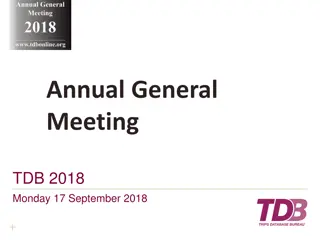
Understanding CPU Scheduling in Operating Systems
Learn about the importance of CPU scheduling in operating systems, the different scheduling schemes, criteria for comparing scheduling algorithms, and popular CPU scheduling algorithms like FCFS and SJF.
Download Presentation

Please find below an Image/Link to download the presentation.
The content on the website is provided AS IS for your information and personal use only. It may not be sold, licensed, or shared on other websites without obtaining consent from the author. If you encounter any issues during the download, it is possible that the publisher has removed the file from their server.
You are allowed to download the files provided on this website for personal or commercial use, subject to the condition that they are used lawfully. All files are the property of their respective owners.
The content on the website is provided AS IS for your information and personal use only. It may not be sold, licensed, or shared on other websites without obtaining consent from the author.
E N D
Presentation Transcript
by Asst. Lecturer Amal A. Maryoosh
Scheduling is a fundamental operating system function. Almost all computer resources are scheduled before use. The CPU scheduling is central to operating systems.
The success of CPU scheduling depends on the following observed property of processes: process execution consists of a cycle of CPU execution and I/O wait. Processes alternate between these two states. Process execution begins with a CPU burst. That is followed by I/O burst, then another CPU burst and so on. The last CPU burst will end with a system request to terminate execution.
Whenever the CPU becomes idle, the operating system must select one of the processes in the ready queue to be executed. The selection process is carried out by the short term scheduler (CPU scheduler). The scheduler selects from among the processes in memory that are ready to execute and allocates the CPU to one of them.
There are two scheduling schemes can be recognized: Preemptive scheduling Non-preemptive scheduling Under the non-preemptive scheduling, once the CPU has been allocated to a process, the process keeps the CPU until it release the CPU either by terminating or by switching to the waiting state. On the other hand Preemptive scheduling occur when the CPU has been allocated to a process and this process is interrupted by higher priority process. At this moment the executing process is stopped and returned back to the ready queue, the CPU is allocated to the higher priority process.
It is the module that gives control of the CPU to the process selected by the CPU scheduler. This function involves: Switching Context Switching to user mode Jumping to the proper location in the user program to restart the program.
Many criteria have been suggested for comparing CPU scheduling algorithms. The criteria include the following: CPU Utilization Throughput Turnaround Time Waiting time Response time
Max CPU utilization Max throughput Min turnaround time Min waiting time Min response time
Here we will mention some of the CPU scheduling algorithms that are used in different operating systems: 1. First Come First Served (FCFS) 2. Shortest Job First Scheduling (SJF) 3. Priority Scheduling Algorithm 4. Round Robin Scheduling Algorithm
Simplest CPU scheduling algorithm. Non preemptive. The process that requests the CPU first is allocated the CPU first. The implementation of the FCFS policy is easily managed with FIFO queue. When the CPU is free, it is allocated to the process at the head of the queue. The average waiting time under the FCFS policy is often quite long.
Process P1 P2 P3 Burst time 24 3 3 The Gantt Chart is as follows: P1 P2 P3 0 24 27 30
What if their order had been P2, P3, P1? Process P1 P2 P3 Burst time 24 3 3 The Gantt Chart is as follows: Waiting Time P1: 0 P2: 3 P3: 6 Completion Time: P1: 3 P2: 6 P3: 30 Average Waiting Time: (0+3+6)/3 = 3 (compared to 17) Average Completion Time: (3+6+30)/3 = 13 (compared to 27) P2 P3 P1 0 3 6 30
Associate with each process the length of its next CPU burst. When the CPU is available, it is assigned to the process has the smallest next CPU burst. If two processes have the same length, FCFS scheduling is used to break this tie. The SJF is either preemptive or non-preemptive. - Non preemptive: once CPU given to the process it cannot be preempted until completes its CPU burst. - Preemptive: if a new process arrives with CPU burst length less than remaining time of current executing process, preempt. This scheme is known as the Shortest Remaining Time First (SRTF).
SJF (non-preemptive) Process P1 P2 P3 P4 Burst Time 6 8 7 3 The Gantt Chart is as follows: P1 P3 P2 P4 28 9 16 0 3 P1 waiting time: 0 P3 waiting time: 3 P2 waiting time: 9 P4 waiting time: 16 The total Execution time is: 28 M.s The average waiting time (AWT): (0+3+9+16)/ 4 = 7 M.s
SJF (preemptive) Process P1 P2 P3 P4 Arrival Time 0 1 2 3 Burst time 8 4 9 5 The Gantt Chart is as follows: P2 P1 P4 P1 P3 10 26 0 5 17 1 P1 waiting time: 10-1 P2 waiting time: 0 P3 waiting time: 17-2 P4 waiting time: 5-3 The total Execution time is: 28 M.s AWT = ((10-1)+(1-1)+(17-2)+(5-3))/ 4 = 6.5 M.s
A priority number (integer) is associated with each process. The CPU is allocated to the process with the highest priority (smallest integer highest priority). Can be preemptive (compares priority of process that has arrived at the ready queue with priority of currently. running process) or non- preemptive (put at the head of the ready queue). Problem Starvation low priority processes may never execute. Solution Aging as time progresses increase the priority of the process.
Process P1 P2 P3 P4 P5 Burst Time 10 1 2 1 5 Priority 3 1 3 4 2 The Gantt Chart is as follows: P2 P5 P1 P3 P4 0 6 16 18 19 1 P1 waiting time: 6 P2 waiting time: 0 P3 waiting time: 16 P4 waiting time: 18 P5 waiting time The total running time is: 19 The average waiting time (AWT): (6+0+16+18+1)/5 = 8.2 M.s 1 :
The Round Robin is designed for time sharing systems. The RR is similar to FCFS, but preemption is added to switch between processes. Each process gets a small unit of CPU time (time quantum or time slice), usually 10-100 milliseconds. The ready queue is treated as a circular queue ,the CPU scheduler goes around the ready queue allocating the CPU to each process for a time interval of up to 1 time quantum.
One of two things will then happen : A.The process may have a CPU burst of less 1 TQ . In this case the process itself will release the CPU voluntarily . the scheduler will then proceed to the next process in the ready queue. B. If the CPU burst of the currently running process is longer than 1 time quantum , the timer will go off and will cause an interrupt to the O.S. A context switch will be executed and the process will be put at the tail of the ready queue . The CPU scheduler will then select the next process in the ready queue. The A.W.T in RR is often quite long.
with Time Quantum = 4 Process P1 P2 P3 Burst time 24 3 3 Waiting Time: P1: (10 - 4) = 6 P2: (4 - 0) = 4 P3: (7 - 0) = 7 The Gantt Chart is as follows: P1 P1 P1 P2 P1 P1 P1 P3 4 30 0 10 14 18 22 26 7 Completion Time: P1: 30 P2: 7 P3: 10 Average Waiting Time: (6 + 4 + 7) /3 = 5.67 M.s Average Completion Time: (30+7+10) /3 =15.67 M.s
Algorithms Policy type Disadvantages Advantages Average waiting time is often quite long. Need to know the length of the next CPU request. Easy to implement. Gives minimum average waiting time. 1-Simplicity. 2-support for priority. FCFS Non preemptive Non preemptive Or preemptive SJF Non preemptive Or preemptive Blocking or starvation. Priority If the set time is too long, then the system may become unresponsive, time wasting and would emulate First Come First Served. It is easy to implement in software R.R preemptive






















